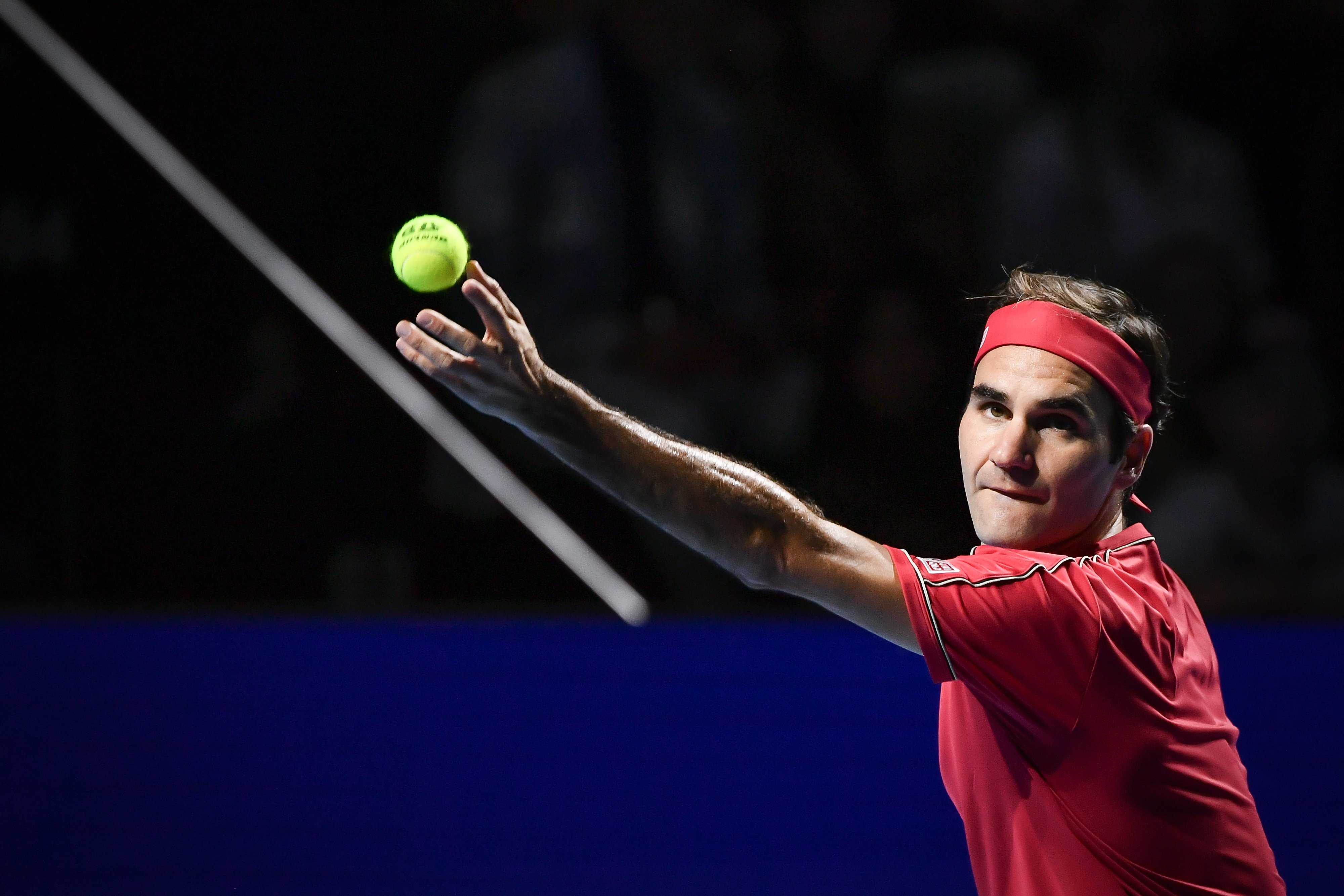We often muse about the evolution of the style of play over the last few decades. It is relatively simple to identify a turning point in the introduction of new materials, which progressively led to the obsolescence of wooden racquets starting in the 1980s. It can be said that the swan song of the old wooden racquets took place with Miloslav Mecir’s victory at Indian Wells in 1989 (a player as talented as he is unjustly forgotten). From that moment on, all the major tournaments were won by athletes brandishing a more modern racquet with a bigger sweet spot, a much wider point of impact at maximum effectiveness, which now extends to pretty much the whole of the racquet head.
From that moment on, the tennis style, at least at the highest levels and in particular for men (who traditionally hit harder) changed in favour of baseline rallies instead of net play, following in Bjorn Borg’s footsteps (thanks to the greater effectiveness of topspin shots which, because of new technologies, can be successful even from defensive positions). The 90s were mostly characterised by the Sampras-Agassi dualism, i.e. the challenge between an extraordinary server and an exceptional returner. After a short interregnum, Federer, Nadal and then Djokovic appeared on the scene, three players who have broken almost every record, especially in the Slams.
However, these three legends are quite difficult to classify in their playing styles – the same cannot be said for their competition, though. In the same period, we can identify, just behind them, players such as Murray, Roddick, Del Potro, Wawrinka: all equipped with a very solid first serve. And the same can be said for the elusive Next Gen, which has been awaited to take over for a few years, although at the moment it seems that they’ll still have to wait awhile. Likewise, the majority of the new contenders make the serve a cornerstone of their game: think for example of Medvedev, Sascha Zverev, Tsitsipas or Thiem.
Is the serve becoming increasingly important over time? The data made available on the ATP website, which include rather detailed statistics on all the matches held from 1991 to 2017, allow us to test this hypothesis more systematically. For this purpose, we will distinguish three periods within our analysis: 1991-1999, 2000-2009 and 2010-2017. We will compare them in statistical and data-driven terms, with a careful look at the role of the serve.
ACE RATES
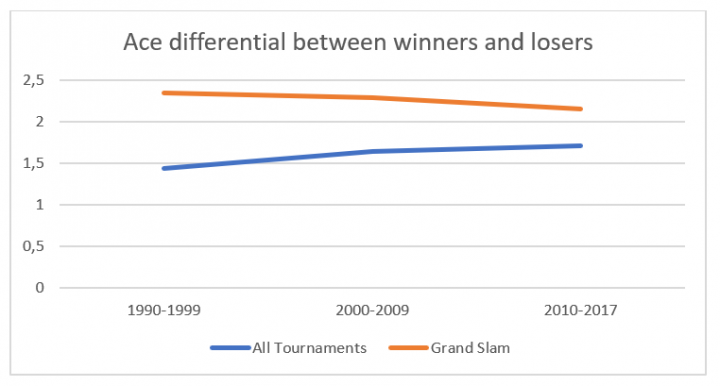
First of all, we can verify whether, and to what extent, the winner is also the player who hits the most aces: even if there are different degrees, this is the case in all three periods considered. In the 1990s, in fact, the average difference between the winner and the loser in terms of ace is 1.44. It reaches 1.64 in the first ten years of the new millennium (marking a strong growth, +13.8%) and 1.71 in the last period considered, from 2010 to 2017. It would therefore be tempting to conclude that the serve, in its most direct manifestation of effectiveness (the ace), has gained an increasing weight in determining the winner of a high-level match.
But what happens if we narrow the analysis to the Grand Slam tournaments, which represent the most important moments of the season, with all the big players competing (injuries notwithstanding)? In this case, the result is diametrically opposite: the difference measured in the 90s is 2.35 and decreases to 2.29 in the early 2000s. This difference settles, on average, at 2.15 in the last period considered.
At this point, however, we are reminded of the words of Andre Agassi, who often received comments related to the not exceptional effectiveness of his serve compared to the rest of his game. The American acutely observed that very often, and in particular when he was able to hit a first serve, even if he did not get a direct point, he put himself in a position to play an easy shot immediately after the serve. Considering the effectiveness of his groundstrokes, this was more than enough to make it difficult for the opponent to break his serve and to put him under pressure. On this basis, let’s try to delve more deeply by focusing on another stat, which is more indicative of serve performance overall and not just in terms of direct points: the percentage of points won with the first serve.
PERCENTAGE OF POINTS WON WITH THE FIRST SERVE
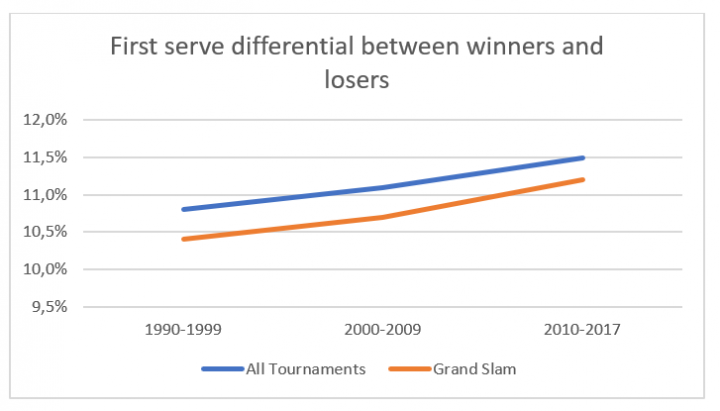
By repeating the analysis and applying it to this new statistic, we actually obtain a concordant result, both considering the totality of the tournaments or just the Slams. Considering every tournament, in the 1990s the winner of a match gets a percentage of points with the first serve that exceeds that of the losing player by 10.8%. In the early 2000s, the gap rises to 11.1%, reaching 11.5% in the third period considered (2011-2017). Focusing on Grand Slam tournaments, the trend remains similar in relative terms, although starting from a slightly lower base: the initial average difference is 10.4% in the 1990s, which grows to 10.7% and finally to 11.2% in the two subsequent periods considered.
We can conclude that, in average terms, the player who wins the match is the one who manages to get points from his first serve, thus imposing his game on the opponent. Once again, let’s try to re-read the data between the lines, considering another observation made by a great tennis player, former world number three and now Roger Federer’s coach: Ivan Ljubičić. During an interview, he was asked to compare Federer’s serve to that of other players, including Stan Wawrinka. Ljubo highlighted that, even though Wawrinka was able to reach higher speeds on the first ball, Federer was gifted with a more complete and unpredictable serve. But that’s not all.
One of the strengths of Federer’s serve is the second ball. “On Roger’s second ball“, concluded the Croatian coach, “it may be relatively simple to return, but it is still very complicated to attack“. In this sense, we look at another aspect of the serve: not only as a definitive shot (ace) or an aggressive one (first ball), but also as a tool to avoid being a victim of the opponent’s aggressive return: in a certain sense, it is a maneuvering shot, if not an outright defensive one. So, let’s try to ask ourselves if, especially at high levels, the second serve is key to victory, and the weight it takes throughout the years.
PERCENTAGE OF POINTS WON WITH THE SECOND SERVE
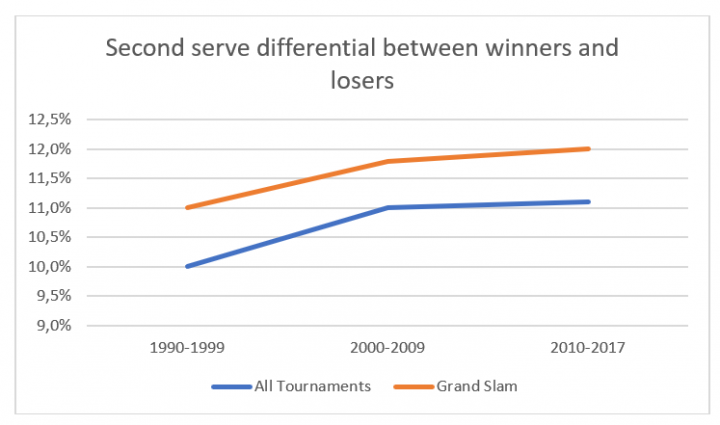
Again, we will first examine all the tournaments, and then focus on the Australian Open, the French Open, Wimbledon, and the US Open. Considering the former, we identify a decisive step forward between the 1990s and the early 2000s, with the difference in terms of the percentage of points won on the second serve which goes up, on average, from 10% to 11%. Over the following years, up to 2017, there was still a slight growth, which leads to an average gap of 11.1%.
Focusing on the Grand Slam tournaments, we register a similar dynamic but, in this case, starting from a higher base: we go from an average gap of 11% (90s) to 11.8% (early 2000s), to reach an average difference of 12% on the points won with the second serve in the period 2010-2017.
Thinking back to what we observed in terms of percentage of points won on the first serve, we can assume that, in a best-of-five event, especially in the advanced stages of a match, players lose both brilliance and precision. It is therefore not surprising that the longer rallies, which start from a second and not from a first serve, end up determining the result of a match.
Starting from a first intuitive observation based on the evolution of playing styles, we have collected evidence that seems to support, in different forms, that the pattern suggested by intuition (the growing importance of the serve) is reflected in the data. Now let’s try to take a step back and, buoyed by this, ask ourselves: considering that more and more top players are focusing on their serve, is this shot assuming an increasing importance even in matches between Top 10 players
THE TOP 10

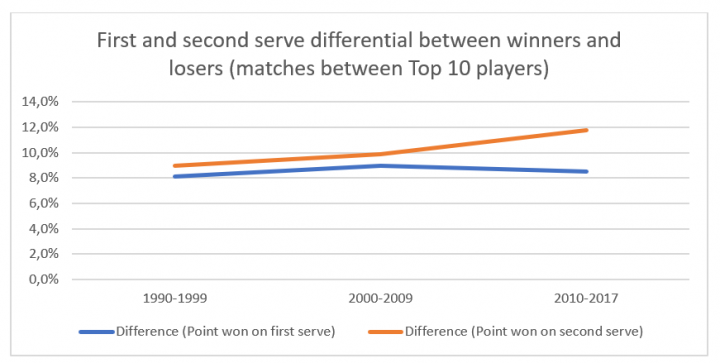
By examining picture 4, it can be noticed how the evolution of the role of the serve seems to be characterised in a different way, at least in the last three decades, in matches between Top 10 players. As for the difference in terms of aces between winners and losers, we witnessed a growth in the early 2000s, followed by a marked decrease in the period 2010-17.
It is also worth noting how the average values associated with Top 10 matches are higher than the average values, considering all the matches in the first two decades. In other words: in the 1990s and in the early 2000s, the difference in terms of aces between winner and loser in a Top 10 match was on average twice as much as the difference between aces in any other match. Between 2011 and 2017, however, the difference for the Top 10 is less than half of that associated with a generic match. The statistics relating to the points won on the first and on the second serve confirm this. The first serve becomes almost a “must have” at a high level and, for this reason, it cannot be the shot that “makes the difference” – because everybody has it.
The percentage of points won with the first serve grew from 8.1% in the 1990s to 9% in the early 2000s, then decreased to 8.5% in the year 2010-2017. On the contrary, the performance with the second serve grew in both decades, with an acceleration in the last analysed timespan. On average, we move from a 9% difference in the 90s to a 9.9% difference between 2000 and 2009. Then we reach an 11.8% difference between 2010 and 2017. We would therefore conclude that the serve has become a sort of business card to be presented at the entrance of the club of the best players in the world: a shot that cannot be ignored but that is not enough to beat the opponents, and thus to conquer Grand Slams et similia.
Let’s now try to verify this hypothesis once again by recalculating the statistics about the effectiveness of the serve, this time making a distinction between surfaces. In other words, let’s try to answer this question: is what we have deduced valid both on grass, on hard, and on clay?
GRASS, HARD AND CLAY

By observing the trend of the difference in aces between winner and loser by surface, we observe how the gap between clay and hard court is roughly constant. This would raise more doubts over the theory according to which surfaces tend to be more and more alike over the last few years. There is a dissonant dynamic with regards to grass, in contrast with the other surfaces and the global average analyzed in section 2. In this regard, it can be observed that there are fewer and fewer serve & volley players, even on grass. In this sense, therefore, we can imagine that even a mediocre server will look to hit an ace when he hits the first serve on that surface. Consequently, he won’t want or need to end the point at the net. Due to the decreasing frequency of net approaches, the service box, especially in the final rounds of the tournaments, tends to return higher speeds than the baseline, an area where the grass is worn out and thus slower. Hitting a very fast first serve and going for an ace can therefore be the way to go for many players. It should also be noted, however, that even during the last period covered the difference in aces, in absolute terms, is greater on grass than on hard and clay, despite a downward trend.

Considering the average difference in terms of percentage of points won with the first serve, and making a distinction not only by period but also by surface, we observe a different trend. On grass and on clay, the gap tends to grow (particularly on clay, from the 1990s to the first years of 2000s), while for hardcourts the statistics are more or less stable, with a slight decline in the early 2000s followed by a small increase starting in 2010. Perhaps it is the statistics about the clay that deserve specific reflection. While trying to analyse this growth, we can reflect on the fact that the early 2000s marked the success of players on clay courts (apart from Nadal) who make the power of their shots a winning card. The dirt aficionado, therefore, is no longer a Sergi Bruguera or a Thomas Muster, who were pure pushers, but rather players who attacks from the baseline: from this point of view, we can just recall the remarkable results of Wawrinka, or even of Federer himself. In this sense, therefore, even if the surface tends to reduce the number of direct points with the serve, it can be understood how these players end up creating a gap between themselves and the opposition in terms of percentage of points won with the first serve.
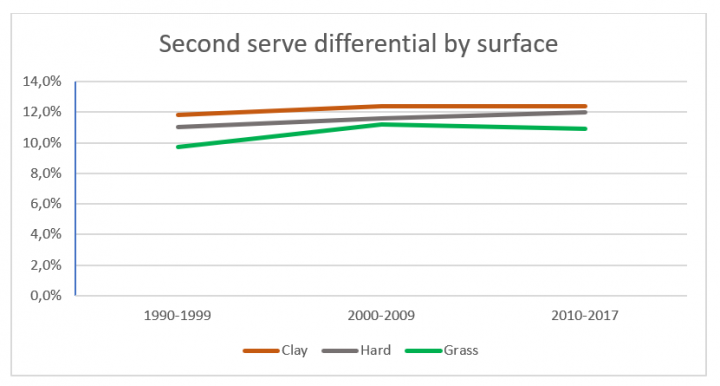
The difference in terms of points won on the second serve shows similar trends between the three surfaces. In all three periods considered, the greatest difference is on clay, followed by hard and grass. Grass is experiencing a significant growth (from 9.7% to 11.2%) from the early 2000s, perhaps due to the fact that more and more players, even on grass, play from the baseline.
Given all the previous considerations, it could perhaps be observed that, at least starting from the early 2000s, despite the growing importance of the serve, the greatest difference between winner and loser is in terms of percentage of points won on the second serve, and not on the first one. This phenomenon is even more pronounced in Top 10 matches. This is what the data are telling us. However, we should try not to receive them like a verdict, but rather to interpret them like a story. As Dostoevsky recalled in Crime and Punishment, “Facts are not everything – at least half the business lies in how you interpret them.”
Article by Damiano Verda; translated by Luca Rossi; edited by Tommaso Villa




